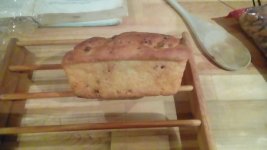My Italian grandmother used to make sausage bread when we were kids. It had eggs mixed in with it and was outstanding; great cold too.
Etpm, thanks for sharing and bringing me down memory lane. Any chance you can post a copy of the actual recipe? Would be great to try this myself.
Sure, I'll post the recipe. Remember that the sausage you use will have a large impact on the taste. I use my own sausage, that I grind and season myself. This recipe really works well with home made sausage.
The recipe below is adapted from the 1979 edition of the Fannie Farmer Cookbook. I just changed slightly amounts and methods. The Fannie Farmer cookbooks are pretty good cookbooks overall but are also good books for beginning cooks because there are lots of explanations about how things work when cooking, what certain ingredients do, and the properties of ingredients, such as the differences between flours.
For two loaves:
2 Tbs olive oil
2 Tbs plus a pinch of sugar
2 1/2 Tsp salt
1 1/3 cups water, divided
1 Cup milk
1 package or 2 1/4 Tsp or 7 grams dried yeast
6 cups white unbleached flour
12 ounces after cooking sausage. Breakfast sausage and Italian sausage both work well.
First thing cook the sausage. Crumble the sausage while it's cooking. Cook the sausage until it's just barely done. It will cook more when the bread is baking and the flavors from the sausage will permeate the bread. If the sausage is overcooked in the pan it will not release as much flavor and will not be tender enough. Drain the sausage on paper towels if it's too fatty. You, the baker, be the judge.
Put the yeast and a pinch of sugar into a small bowl. Add 1/3 cup warm water. Let it sit for a few minutes so that the yeast gets completely saturated with water. Then give it a stir so that the yeast is completely mixed into the water. Mix the remaining 1 cup water with the milk in a bowl and microwave until the mixture reaches 100 to 110 degrees F. Mix the oil, salt, and 2 Tbs sugar in a large bowl. Add the warm water and milk. Stir well. The yeast in the bowl should be all foamy now. If it doesn't foam up it's dead and you need some new yeast. Empty the small bowl of foamy yeast into the large bowl and stir well. Pour in 3 cups of the flour and mix well. Now mix in the remaining 3 cups of flour. Empty the bowl onto a large floured board. Knead dough for a couple minutes, let rest for 10 minutes, then knead again until the dough is smooth and elastic. All the mixing and kneading can also be done with a large stand mixer with a dough hook too. Oil a large bowl with some olive oil and put the dough into the bowl. Cover the bowl with plastic wrap and let it sit in a warm place until it doubles in size. Punch the dough down and then turn the dough out onto a well floured big surface. Pat, roll, stretch the dough, whatever works for you, until the dough is about 1/2 inch thick. Spread the cooked sausage evenly over the dough. Now fold and knead the dough until the sausage is evenly distributed throughout the dough. Divide the dough into two and shape into loaves. Oil up two 9 inch loaf pans and put the divided dough into the pans. Cover and let rise in the pans until double in size. Put into a pre-heated 425 degree oven. Bake for 15 minutes, reduce heat to 375 and continue baking for another 30 minutes. Remove from oven and cool on racks.
Note: I have tried adding the cooked sausage right at the beginning, with the first 3 cups of flour, and with the second 3 cups of flour. It's a hassle though because of the kneading. I have also added the sausage right after the kneading but before the first rise. But that wasn't as easy as adding the sausage after the first rise, after the dough has been punched down.
Eric

